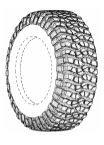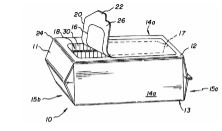Author
A quick summary of recent happenings at the intersection of consumer products and IP:
- Design Patent Owners See Quick Settlement – In the July issue of The Goods on IP®, we discussed the design patent infringement suit brought by Michelin against
 after-market tire refurbishing company Tire Recappers. The two patents at issue, U.S. Patent Nos. D530,266 and D639,235, are for tire tread designs. Last month, an undisclosed settlement was entered only two months after the lawsuit was filed. The quick settlement is not surprising. Design patent litigation – high profile cases like Apple v. Samsung notwithstanding – typically settles quickly, and more often favorably to the patent owner. The question of infringement, particularly in the case of knock-offs, is often clear and straightforward, and protracted litigation is unnecessary.
after-market tire refurbishing company Tire Recappers. The two patents at issue, U.S. Patent Nos. D530,266 and D639,235, are for tire tread designs. Last month, an undisclosed settlement was entered only two months after the lawsuit was filed. The quick settlement is not surprising. Design patent litigation – high profile cases like Apple v. Samsung notwithstanding – typically settles quickly, and more often favorably to the patent owner. The question of infringement, particularly in the case of knock-offs, is often clear and straightforward, and protracted litigation is unnecessary. - Fed. Cir. Split on Objective Indicia of Non-obviousness in Cookie Packaging Case – Objective indicia of non-obviousness, including commercial success and industry praise, are often important to defending the patentability of patents involved in consumer product litigation. In Intercontinental Great Brands v. Kellogg N. Am. Co., a divided Federal Circuit panel affirmed that Kraft’s resealable cookie packaging patent was an obvious combination of two known kinds of packaging: a common cookie container, in which a frame is surrounded by a wrapper, and a resealable package used for wet wipes, in which a label is pulled back to access its contents. The patent at issue, U.S. Patent No. 6,918,532, was directed to Kraft’s “Snack-N-Seal” resealable package, which is used in its Oreos and Chips Ahoy! Products. In a 2-1 decision, the appeals court found that the district court adequately considered Kraft’s evidence of secondary considerations but the evidence was insufficient to overcome the strong case of obviousness.
In his dissent, Judge Reyna argued that “objective indicia of non-obviousness must be considered from the outset,” and the court’s application of a prima facie test for obviousness achieves a legal determination “prior to full and fair consideration of evidence of objective indicia.” We discussed more on secondary considerations in this month’s Perspectives on the PTAB newsletter.
- Design and Trade Dress Infringement Alleged in Cosmetic Device Lawsuit – Given the important role that aesthetic features and appearance often play in a product’s success, consumer product cases often include claims based on both design patent rights and trademark rights. A lawsuit filed by a cosmetic product company this month includes this approach. DD Karma sued Michael Todd Beauty alleging that its sonic dermaplaning tool infringes U.S. Patent No. D786,499 for a hand held electronic cosmetic device, as well as its common law trademark and Federal trade dress rights in the product. Images of the patented design and the accused product are reproduced below. What do you think?
- Managing the “Functionality” Issue – Effectively managing the full complement of IP options available – utility and design patents, trademarks, copyrights, trade secret – in a consumer product portfolio is critical. This is particularly so in the context of “functionality” attacks from competitors. In an October precedential ruling, the Trademark Trial and Appeal Board canceled registrations held by Illinois Tool Works Inc. for reclosable plastic bags on the grounds they were functional, i.e. utilitarian features to be covered solely by utility patent. An important factor that led to the cancellations was that ITW indeed owned an expired utility patent covering the same designs.
An interesting aside in the case is that there was no evidence that ITW had also filed for design patent protection. Had they successfully obtained design patents on the bags at issue, ITW may have had a stronger argument that the design was not functional. The subject matter of a U.S. design patent cannot be primarily functional. Although such arguments may not always succeed, consumer product companies must nevertheless take a comprehensive approach to protecting their IP in order to have flexible enforcement options during a product’s lifecycle. - Venue at Issue in Bagged Cereal Merchandiser Design Lawsuit – In another food industry patent lawsuit, Post Consumer Brands sued General Mills alleging infringement of its design for a shelf divider for bagged food items. Post alleges that General Mills infringes U.S. Patent No. D798,091 covering a merchandising system that allows consumers to see behind the front display panel to discern the brand of ready-to-eat bagged cereal. In a motion ruling this month that cites to TC Heartland, the court granted General Mills’ motion to transfer venue from the Eastern District of Missouri to the District of Minnesota, where the defendants are headquartered. The court found that the General Mills plant in Missouri was operated by GM Operations, which was not a named defendant, and that the presence of a corporate relative in the district did not establish venue. The “handful” of defendant employees at the plant did not satisfy the requirement that defendant have a “physical” place of business in the district, according to the decision.
This article appeared in the October 2017 issue of The Goods on IP® Newsletter.
Related Industries

Stay in the Know
Receive insights from the most respected practitioners of IP law, straight to your inbox.
Subscribe for Updates
 In his dissent, Judge Reyna argued that “objective indicia of non-obviousness must be considered from the outset,” and the court’s application of a prima facie test for obviousness achieves a legal determination “prior to full and fair consideration of evidence of objective indicia.” We discussed more on secondary considerations in this month’s Perspectives on the PTAB
In his dissent, Judge Reyna argued that “objective indicia of non-obviousness must be considered from the outset,” and the court’s application of a prima facie test for obviousness achieves a legal determination “prior to full and fair consideration of evidence of objective indicia.” We discussed more on secondary considerations in this month’s Perspectives on the PTAB 